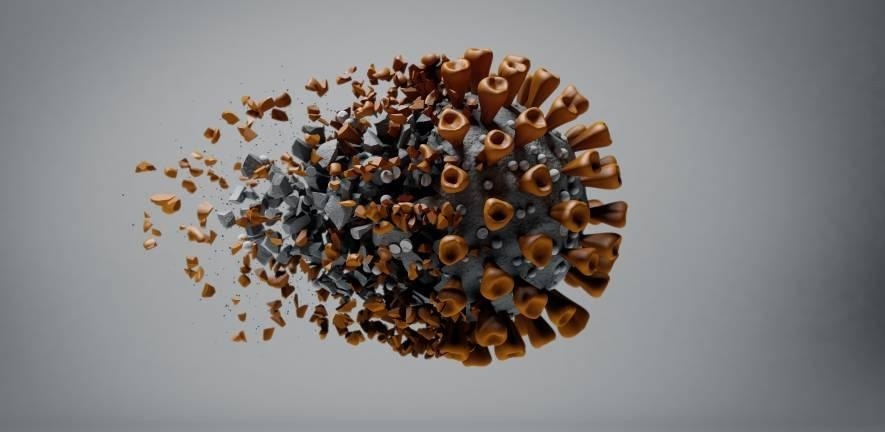As an approach that could be used to create a new class of antiviral drugs, synthetic biology was used by Cambridge scientists to artificially create enzymes programmed to attack the genetic code of SARS-CoV-2 and eliminate the virus.
 A 3d animation of the COVID-19 Virus or Coronavirus being broken apart. Image Credit: Jordan Siemens (Getty Images)
A 3d animation of the COVID-19 Virus or Coronavirus being broken apart. Image Credit: Jordan Siemens (Getty Images)
The chemical transformations necessary for our bodies to function, from translating the genetic code into proteins to digesting food, are made possible by enzymes, which are naturally occurring biological catalysts.
Even though proteins make up the majority of enzymes, some of these vital reactions are also catalyzed by RNA, a chemical relative of DNA that can fold into an enzyme called a ribozyme. Certain classes of ribozymes can precisely target and cut particular sequences in other RNA molecules.
The year 2014 saw the discovery by Dr Alex Taylor and colleagues that XNA, or synthetic chemical substitutes for RNA and DNA not found in nature, could be used to make the first fully artificial enzymes, which Taylor called XNAzymes.
XNAzymes were not at all effective at first and needed improbable lab settings to work. But earlier this year, his lab published research on a new class of XNAzymes that had been specially designed to be much more effective and stable inside cells.
Due to their extreme precision, these synthetic enzymes can cut long, complex RNA molecules, and if the target sequence differs by just one nucleotide (the fundamental building block of RNA), they will recognize not to cut it. This implies that they can be set up to target mutated RNAs linked to cancer or other diseases while sparing the normal RNA molecules.
Taylor and his team at the Cambridge Institute of Therapeutic Immunology & Infectious Disease (CITIID), University of Cambridge, describe how they were able to successfully “kill” a live SARS-CoV-2 virus using this technology in a study that was just published in Nature Communications.
Put simply, XNAzymes are molecular scissors which recognize a particular sequence in the RNA, then chop it up. As soon as scientists published the RNA sequence of SARS-CoV-2, we started scanning through looking for sequences for our XNAzymes to attack.”
Dr Alex Taylor, Sir Henry Dale Fellow and Affiliated Researcher, St John’s College
Although these synthetic enzymes can be programmed to recognize particular RNA sequences, the XNAzyme’s catalytic core, or the mechanism that drives the “scissors,” remains the same. This means that it is possible to produce new XNAzymes in a fraction of the time it usually takes to produce antiviral medications.
“It is like having a pair of scissors where the overall design remains the same, but you can change the blades or handles depending on the material you want to cut. The power of this approach is that, even working by myself in the lab at the start of the pandemic, I was able to generate and screen a handful of these XNAzymes in a matter of days,” Taylor added.
Using the state-of-the-art Containment Level 3 Laboratory at CITIID, the largest academic facility in the nation for researching high-risk biological agents like SARS-CoV-2, Taylor and Dr Nicholas Matheson then worked together to demonstrate that their XNAzymes were effective against live SARS-CoV-2 virus.
It is really encouraging that for the first time – and this has been a big goal of the field—we actually have them working as enzymes inside cells, and inhibiting replication of live virus.”
Dr Pehuén Pereyra Gerber, Research Associate, Department of Medicine, University of Cambridge
Dr Matheson, a Research Fellow at the University of Cambridge, stated, “What we have shown is proof of principle, and it is still early days. It is worth remembering, however, that the amazingly successful Pfizer and Moderna COVID-19 vaccines are themselves based on synthetic RNA molecules—so it is a really exciting and rapidly developing field, with enormous potential.”
Taylor ensured that the target viral sequences were not found inside the RNA by comparing them to databases of human RNAs. The highly specific nature of the XNAzymes should, in theory, prevent some of the “off-target” side effects that related, less precise molecular therapeutics might bring about, such as liver toxicity.
SARS-CoV-2 has the capacity to change and evolve, giving rise to new variants that vaccines are less effective against. Taylor devised three of the XNAzymes to self-assemble into a “nanostructure” that cuts various portions of the viral genome to circumvent this issue in addition to targeting viral RNA regions that mutate less frequently.
Taylor stated, “We are targeting multiple sequences, so for the virus to evade the therapy it would have to mutate at several sites at once. In principle, you could combine lots of these XNAzymes together into a cocktail. But even if a new variant does appear that is capable of getting round this, because we already have the catalytic core, we can rapidly make new enzymes to keep ahead of it.”
XNAzymes could be given as drugs to treat COVID-19 infections and help patients recover, or they could be used to protect those who have been exposed to the virus and stop it from spreading. This kind of strategy could be vital for patients whose weakened immune systems make it difficult for them to get rid of the virus on their own.
Making XNAzymes that are even more specialized, strong, and “bulletproof,” as Taylor puts it, is Taylor and his team’s next step. This will enable them to stay in the body for longer and function as catalysts even more effectively in smaller doses.
Source:
Journal reference:
Gerber, P. P., et al. (2022). XNAzymes targeting the SARS-CoV-2 genome inhibit viral infection. Nature Communications. doi.org/10.1038/s41467-022-34339-w